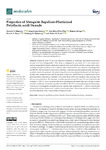Mostrar o rexistro simple do ítem
Properties of Mosquito Repellent-Plasticized Poly(lactic acid) Strands
| dc.contributor.author | Mapossa, Antonio B. | |
| dc.contributor.author | López-Beceiro, Jorge | |
| dc.contributor.author | Díaz-Díaz, Ana-María | |
| dc.contributor.author | Artiaga, Ramón | |
| dc.contributor.author | Moyo, Dennis | |
| dc.contributor.author | Mphateng, Thabang N. | |
| dc.contributor.author | Focke, Walter W. | |
| dc.date.accessioned | 2021-12-01T16:27:35Z | |
| dc.date.available | 2021-12-01T16:27:35Z | |
| dc.date.issued | 2021-09 | |
| dc.identifier.citation | Mapossa, A.B.; López-Beceiro, J.; Díaz-Díaz, A.M.; Artiaga, R.; Moyo, D.S.; Mphateng, T.N.; Focke, W.W. Properties of Mosquito Repellent-Plasticized Poly(lactic acid) Strands. Molecules 2021, 26, 5890. https://doi.org/10.3390/molecules26195890 | |
| dc.identifier.issn | 1420-3049 | |
| dc.identifier.uri | http://hdl.handle.net/2183/29051 | |
| dc.description | This article belongs to the Special Issue Thermal and Rheological Characterization of Polymeric Materials | |
| dc.description.abstract | [Abstract] Poly(lactic acid) (PLA) is an attractive candidate for replacing petrochemical polymers because it is fully biodegradable. This study investigated the potential of PLA as a sustainable and environmentally friendly alternative material that can be developed into commercially viable wearable mosquito repellent devices with desirable characteristics. PLA strands containing DEET and IR3535 were prepared by twin screw extrusion compounding and simultaneously functioned as plasticizers for the polymer. The plasticizing effect was investigated by thermal and rheological studies. DSC studies showed that the addition of DEET and IR3535 into PLA strands reduced the glass transition temperature consistent with predictions of the Fox equation, thus proving their efficiency as plasticizers. The rheology of molten samples of neat PLA and PLA/repellents blends, evaluated at 200 °C, was consistent with shear-thinning pseudoplastic behaviour. Raman studies revealed a nonlinear concentration gradient for DEET in the PLA strand, indicating non-Fickian Type II transport controlling the desorption process. Release data obtained at 50 °C showed initial rapid release followed by a slower, near constant rate at longer times. The release rate data were fitted to a novel modification of the Peppas-Sahlin desorption model | es_ES |
| dc.description.sponsorship | This work was financially supported from the Deutsche Forschungsgemeinschaft (DFG), Germany [Grant number AN 212/22-2] and University of Pretoria (UP) Postdoctoral Fellowship programme. The research has been also supported by Spanish MINECO grant MTM2017-82724-R through the ERDF | es_ES |
| dc.description.sponsorship | Deutsche Forschungsgemeinschaft (DFG); AN 212/22-2 | |
| dc.description.uri | https://www.mdpi.com/journal/molecules/special_issues/Thermal_Rheological_Polymeric_Materials | |
| dc.language.iso | eng | es_ES |
| dc.publisher | MDPI | es_ES |
| dc.relation | info:eu-repo/grantAgreement/AEI/Plan Estatal de Investigación Científica y Técnica y de Innovación 2017-2020/MTM2017-82724-R/ES/INFERENCIA ESTADISTICA FLEXIBLE PARA DATOS COMPLEJOS DE GRAN VOLUMEN Y DE ALTA DIMENSION | |
| dc.relation.uri | https://doi.org/10.3390/molecules26195890 | es_ES |
| dc.rights | Atribución 4.0 Internacional | es_ES |
| dc.rights.uri | http://creativecommons.org/licenses/by/4.0/ | * |
| dc.subject | Mosquito repellents | es_ES |
| dc.subject | Polymer strands | es_ES |
| dc.subject | Thermal analysis | es_ES |
| dc.subject | Rheology | es_ES |
| dc.subject | Desorption | |
| dc.title | Properties of Mosquito Repellent-Plasticized Poly(lactic acid) Strands | es_ES |
| dc.type | info:eu-repo/semantics/article | es_ES |
| dc.rights.access | info:eu-repo/semantics/openAccess | es_ES |
| UDC.journalTitle | Molecules | es_ES |
| UDC.volume | 26 | es_ES |
| UDC.issue | 19 | es_ES |






